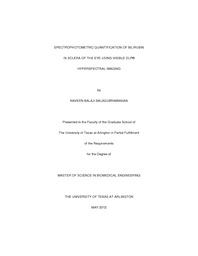
ATTENTION: The works hosted here are being migrated to a new repository that will consolidate resources, improve discoverability, and better show UTA's research impact on the global community. We will update authors as the migration progresses. Please see MavMatrix for more information.
Show simple item record
| dc.contributor.author | Balasubramanian, Naveen Balaji | en_US |
| dc.date.accessioned | 2012-07-25T19:07:51Z | |
| dc.date.available | 2012-07-25T19:07:51Z | |
| dc.date.issued | 2012-07-25 | |
| dc.date.submitted | January 2012 | en_US |
| dc.identifier.other | DISS-11712 | en_US |
| dc.identifier.uri | http://hdl.handle.net/10106/11023 | |
| dc.description.abstract | In clinical settings doctors strive to give best care to the patients by looking for methods to diagnose the illness early to intervene with the necessary treatment. In the case of patients with liver problems (e.g. cirrhosis, hepatitis) an early indicator of impaired liver function is an increased concentration of bilirubin in the blood circulation. Bilirubin concentration is currently quantified by blood sampling, which is invasive, and it would be desirable to have a technology that quantifies bilirubin non-invasively. The goal of this work was to help address this clinical need and develop a methodology for determining non-invasively a measure of bilirubin concentration. This technology consisted of Digital Light Processing Hyperspectral Imaging (DLP HSI) system coupled to a fundus microscope. In this system light from a polychromatic visible light source s dispersed onto a micromirror array of a DLP chip so that each column of micromirrors could reflect only a narrow band of monochromatic light. Programming columns of mirrors turn towards or away from light illumination thus enabled control of the spectral output of the light source. The DLP chip was programmed so that light in 5nm wavelength bins was reflected sequentially across a 440 -500 nm range. The back-reflected light from the scleral area was collected by the fundus microscope optics and projected onto a CCD camera, which was time-synced with the DLP chip so as to acquire images separately for each wavelength bin. The detected Hyperspectral reflectance data cubes from the scleral area were subsequently analyzed to quantify the relative absorbance of Bilirubin in the vicinity. Quantification of these chromophores was based on their known absorbance spectra for each image pixel. Limitations of this work that precluded absolute quantification of chromophores were that the scleral tissue optical properties were not taken into account in the analysis and that the light wavelength range used was not wide enough to uniquely unmix Bilirubin from the hemoglobin spectra. Nevertheless, the estimated relative Bilirubin absorbance values, with respect to blood, showed reasonably good correlation with independent quantitative measurements of bilirubin concentration from blood samples obtained from each patient being imaged. Therefore, the proposed technique shows good potential as a non-invasive tool for the detection of Hyperbilirubinemia and warrants more detailed future studies in a larger patient population to assess its sensitivity and specificity for the early diagnosis of this condition. | en_US |
| dc.description.sponsorship | Alexandrakis, Georgios | en_US |
| dc.language.iso | en | en_US |
| dc.publisher | Biomedical Engineering | en_US |
| dc.title | Spectrophotometric Quantification Of Bilirubin In Sclera of the Eye Using Visible DLP® Hyperspectral Imaging | en_US |
| dc.type | M.S. | en_US |
| dc.contributor.committeeChair | Alexandrakis, Georgios | en_US |
| dc.degree.department | Biomedical Engineering | en_US |
| dc.degree.discipline | Biomedical Engineering | en_US |
| dc.degree.grantor | University of Texas at Arlington | en_US |
| dc.degree.level | masters | en_US |
| dc.degree.name | M.S. | en_US |
Files in this item
- Name:
- Balasubramanian_uta_2502M_11712.pdf
- Size:
- 11.57Mb
- Format:
- PDF
This item appears in the following Collection(s)
Show simple item record


